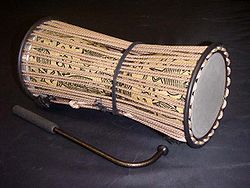Talking drum
It has been suggested that this article be merged into Hourglass drum. (Discuss) Proposed since May 2009. |
This article needs additional citations for verification. (April 2009) |

The talking drum is a West African drum whose pitch can be regulated to the extent that it is said the drum "talks".
History
| Language | Word |
|---|---|
| Akan | Dondo |
| Fante (Gomua) | Odondo |
| Twi | Dondo |
| Dagbani, Gurunsi | Lunna or Donno |
| Hausa, | Kalangu |
| Songhai | Doodo |
| Wolof, Mandinka | Tama or Tamma |
| Bambara, Bozo, Dyula | Tamanin |
| Igbo | Ekwe |
| Yoruba | Dundun, Gangan |
Talking drums are some of the oldest instruments used by west African griots and their history can be traced back to ancient Ghana Empiretimes. The Hausa people (and by influence, the Yoruba people of south western Nigeria and Benin and the Dagomba of northern Ghana) have developed a highly sophisticated genre of griot music centering on the talking drum. Many variants of the talking drum exist, with essentially the same construction mentioned above. Interestingly, this construction is limited to within the contemporary borders of West Africa, with exceptions to this rule being northern Cameroon and western Chad; areas which have shared populations belonging to groups predominant in their bordering West African countries, such as the Kanuri, Djerma, Fulani and Hausa.
Talking drum variance
Dimensions
Various sizes of talking drum exist, with the dimensions of the drum differing between ethnic groups.
The Tama of the Wolof and Mandinka peoples is typified by its smaller dimensions, having a total drum length typical of 5 inches with a 7 centimeter drum head diameter. This produces a much higher pitched tone than other talking drums of the same construction.
The Yoruba and Dagomba peoples on the other hand have some of the largest dimensions for drums in their Lunna and Dùndún ensembles, with a length typical of 9-15 inches and a drum head diameter of between 10-18 centimeters. In Yoruba talking-drum ensembles, this is used alongside smaller talking drums similar to the Tama, called Gangan in Yoruba language.

Playing styles
Playing styles are closely linked with the drum's construction and the tonal qualities of each language. There is a clear difference in playing styles between areas with predominantly Fulani and Mande-speaking populations and traditionally non-Mande areas further east.
The predominant style of playing in areas further west such as Senegal, Gambia, western Mali and Guinea is characterized by rapid rolls and short bursts of sound between the stick holding hand and accompanying free hand, and correlates with the many pitch accent and non-tonal languages heard in this area. This is a style typically heard in the popular Mbalax genre of Senegal.
From eastern Mali, Burkina Faso and Ghana, towards Niger, western-Chad and Nigeria, (with the exceptions of areas with Fulani and Mande-speaking majorities) the playing style of the talking drum is centered on producing long and sustained notes by hitting the drum head with the stick-holding hand and the accompanying free hand used to dampen and change tones immediately after being hit. This produces a rubbery sounding texture to its playing, which mimics the heavy and complex tones used in languages from this area (see Niger-Congo tonal language chart). This characteristic style can be clearly heard in the popular music of this area, particularly in those where the talking drum is the lead instrument, such as Fuji music of the Yoruba of Nigeria.
Use in popular music
In the 20th century the talking drum became a part of popular music in West Africa. It is used in playing Mbalax music of Senegal and in Fuji and Jùjú music of Nigeria (where it is known as a dùndún, not to be confused with the dundun bass drum of the Mandé peoples.)
Tom Waits has used the talking drum on his song "Trouble's Braids," a track from the album Swordfishtrombones.
Erykah Badu used the talking drum on her song "My People", from the album New Amerykah Part One (4th World War).
Naná Vasconcelos, master of percussion, started playing the talking drum in the early 80's and has used it ever since.
Popular culture
In the game series Patapon the player is a god who communicates with his or her followers using four Talking Drums. Each has its own unique sound: 'Pata,' 'Pon,' 'Don' and 'Chaka.'
In the television series Dead Like Me, the talking drum is discussed as a means of celebrating the lives of the dead.
Drum names
In some ethnic groups, each individual was given a drum name. Examples from among the Bulu of Cameroon are "Even if you dress up finely, love is the only thing" or "The giant wood rat has no child, the house rat has no child". Talking drum players sent messages by drumming the recipient's name, followed by the sender's name and the message.[1]
See also
Notes
- ^ "Drum Telegraphy".
who changed this?
References
- "Drum Telegraphy". 21 September 1942. TIME. Online version accessed 7 November 2006.
